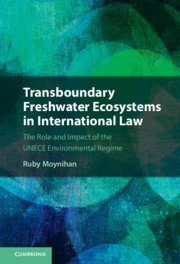 Transboundary Freshwater Ecosystems in International Law
Transboundary Freshwater Ecosystems in International Law Book contents
- Transboundary Freshwater Ecosystems in International Law
- Transboundary Freshwater Ecosystems in International Law
- Copyright page
- Dedication
- Epigraph
- Contents
- Figures
- Preface
- Acknowledgements
- Treaties and Other Instruments
- Table of Cases
- Abbreviations
- 1 The Role of International Law in Addressing the Global Freshwater Ecosystem Crisis
- 2 Conceptualising the UNECE Water and Environmental Regime
- 3 Contemporary Status of International Law on Transboundary Freshwater Ecosystems
- 4 The Common Normative Framework of the UNECE Environmental Regime and Its Contribution to International Water Law
- 5 An Ecosystem Approach in International Law Concerning Transboundary Freshwater Ecosystems
- 6 Public Participation
- 7 River Basin Organisations, Basin Agreements and European Environmental Law in the UNECE Regime
- 8 Transboundary Freshwater Ecosystems in International Law
- Bibliography
- Index
- References
Bibliography
Published online by Cambridge University Press: 01 October 2021
- Transboundary Freshwater Ecosystems in International Law
- Transboundary Freshwater Ecosystems in International Law
- Copyright page
- Dedication
- Epigraph
- Contents
- Figures
- Preface
- Acknowledgements
- Treaties and Other Instruments
- Table of Cases
- Abbreviations
- 1 The Role of International Law in Addressing the Global Freshwater Ecosystem Crisis
- 2 Conceptualising the UNECE Water and Environmental Regime
- 3 Contemporary Status of International Law on Transboundary Freshwater Ecosystems
- 4 The Common Normative Framework of the UNECE Environmental Regime and Its Contribution to International Water Law
- 5 An Ecosystem Approach in International Law Concerning Transboundary Freshwater Ecosystems
- 6 Public Participation
- 7 River Basin Organisations, Basin Agreements and European Environmental Law in the UNECE Regime
- 8 Transboundary Freshwater Ecosystems in International Law
- Bibliography
- Index
- References
Summary

- Type
- Chapter
- Information
- Transboundary Freshwater Ecosystems in International LawThe Role and Impact of the UNECE Environmental Regime, pp. 306 - 318Publisher: Cambridge University PressPrint publication year: 2021
